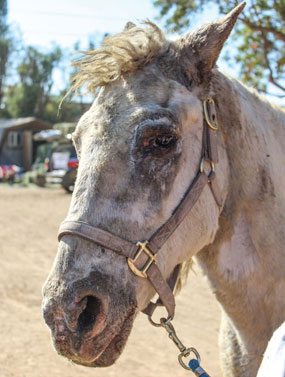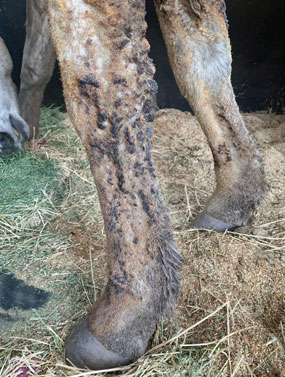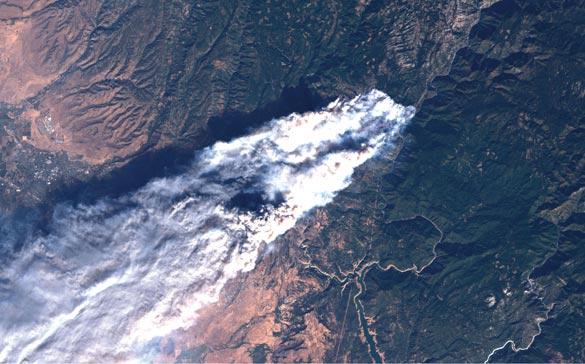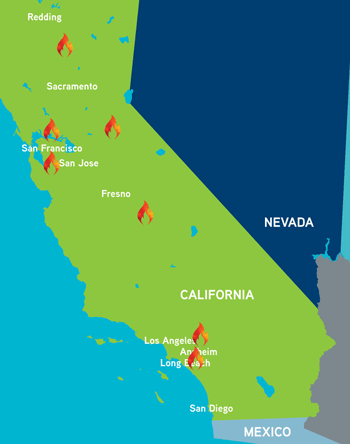California rises from the ashes again
Dr. Valerie Caruso saw a smoke plume in the hills during her commute into Paradise, California, on the morning of Nov. 8, 2018. When Dr. Caruso reached Companion Animal Hospital, she started turning patients away because she thought her practice would lose power as it occasionally did during fires. When an evacuation warning was issued for the town, she packed up the two clinic cats and started to drive. Her home 10 miles down the road in Chico remained untouched, but many of her employees and clients were not so lucky.
"All but one of my employees lost their homes. My associate veterinarian did not lose her home, but she cannot get to it. Ninety-eight percent of my clients lost their homes, and all of my friends that live up there lost their homes," she said. "I know some of (my clients) didn't make it out ... and that's really hard."

While her practice is still standing, Dr. Caruso estimates that it could take more than a year to reopen.
In 2018, California faced its most destructive year of fires. Between Jan. 1 and Dec. 2, 6,228 fires burned 876,225 acres, nearly three times the acreage burned last year, according to the California Department of Forestry and Fire Protection.
California has always been a fire-prone area, but climate change has created a terrain even more susceptible to fires. The Santa Ana winds can also move fires so quickly and unpredictably that firefighters have a hard time containing blazes and residents frequently have little time to evacuate themselves or their pets.
It can be estimated that tens of thousands of animals—pets, wildlife, and livestock—were impacted by the recent fires in the state, according to Allison Cardona, deputy director of the County of Los Angeles Department of Animal Care and Control.
Camp Fire
The Camp Fire near Sacramento is now the deadliest fire in California history, with 85 people dead and three firefighters injured at the time of publication in early December. The fire was 100 percent contained on Nov. 25, 2018. It burned 153,336 acres and destroyed 13,972 houses, 528 commercial buildings, and 4,293 other buildings over 17 days.
In the last few years, the state has seen multiple fires requiring rapid evacuation, which often causes animals to be left behind that need care, shelter, food, and water or transport out, said Dr. John Madigan, professor of medicine and epidemiology at the University of California-Davis School of Veterinary Medicine.
"The severity of the fire (also) makes it a bigger territory to cover so you need more people being able to do shelter work and search and rescue," said Dr. Madigan, who is also director of the UC-Davis Veterinary Emergency Response Team. "It is always a little messy ... very challenging and very long hours ... but we knew what steps we needed to take."




Humane Society of Ventura County equine rescue teams found two horses in a burned-out
pasture in Malibu and transported them to a veterinarian for immediate medical attention.
Flash the horse had burns on his face and other parts of his body and singed hair along his
legs, along with signs of smoke inhalation. He and his companion were later transported to
the HSVC shelter for long-term care. (Photos courtesy of HSVC)
One of the farm animal evacuation locations for the Camp Fire was in Gridley, California, at the Butte County Fairgrounds. The shelter, run by the North Valley Animal Disaster Group, at one time housed 713 animals, from horses to ducks. Dogs and cats were cared for at temporary veterinary clinics put together and run by the California VMA's California Veterinary Medical Reserve Corps, Dr. Madigan wrote in a Nov. 22, 2018, Facebook post on the UC-Davis veterinary school's page.
Getting animals out of immediate danger is just one of many challenging tasks for the students, volunteers, and veterinarians.
"Once you get the animals out of the field, then you have others that need to have food or water and things like that," said Dr. Madigan. "For horses, in the new shelter, they have a neighbor next to them that they don't know (so stress can be high). The biosecurity is really hard to maintain. When you have 150 horses, you can have different things that pop-up—viral infections, eye problems, colic—just because they are equines and under stress. It's general veterinary practice, only with poor working conditions, different feeds, and lots of volunteers to manage."
The Chico Municipal Airport became not only a veterinary clinic but also a distribution center for items needed by the animals' owners. The National Guard and other organizations set up human and animal shelters in Chico.
While the immediate threat of the fire has passed, veterinarians and volunteers must now deal with the aftermath, which includes reuniting pets with their owners. Hayley Gates Dieckmann, president of the Student Veterinary Emergency Response Team Club at UC-Davis and UC-Davis VERT coordinator, said the veterinary school has had a few success stories of animals being reunited with their families through its Facebook page.

Woolsey Fire
Dr. Maria Sabio-Solacito has lost count of the number of major fires she has seen as the veterinary chief of staff of the Los Angeles County Department of Animal Care and Control. "I would say at least six. I have been the head veterinarian for six years, and every year we have a fire or two that we respond to," she said.
You would think that it has become routine, but the challenges are always different, she said.
The Woolsey Fire, which started Nov. 8, 2018, in Los Angeles and Ventura County, caused three fatalities and three firefighter injuries. The fire burned 96,949 acres and was 100 percent contained on Nov. 21, 2018. The fire caused the evacuation of more than 295,000 people.
During a fire, LA County Animal Care and Control mostly assists in evacuation and housing of animals affected by fires in the area, according to Dr. Sabio-Solacito. The organization took in over 812 animals, of which over 500 were horses.
"We triage every animal that comes in, making sure they are free from injury. We try to take care of smoke inhalation the best we can, and then with a burn it is about getting them stabilized, preventing further tissue damage, hydrating, and relieving pain. Whenever the skin is compromised, one of the first things that happens is rapid fluid loss," said Dr. Sabio-Solacito.
Wildlife were also among the animals impacted by the fire. Dr. Stephany Lewis, staff veterinarian for the Malibu-based California Wildlife Center, said the evacuation of the building happened very quickly.
"Friday morning (Nov. 9, 2018) at 3 a.m., we had to make decisions about what animals needed to be evacuated with us and what animals could feasibly be released. I had been evacuated from my own home due to the fire and was unable to get to the wildlife center, so I was on the phone with one of our technicians making these decisions. We only released birds that were in flight cages and would have been released within the next week or so," she said. "(The other patients) were loaded up in the van, and they were all moved to a volunteer's house."

Birds are not usually impacted by fires because they know to fly away, Dr. Lewis said.
"(Wild animals) do a lot better than most people think they do," she said. "They have good instinct to avoid the fires. We do occasionally see some rabbits and other mammals that experience burn trauma and smoke inhalation. A lot of times they get in trouble because they encounter human-made obstacles while they are trying to escape," Dr. Lewis said.
As of publication, Dr. Lewis had consulted on a case involving a rabbit injured by the fire, received a bobcat with badly burnt paws, and was anticipating the arrival of a coyote with burnt paws.
The entire surrounding area was damaged by the fires, according to Dr. Lewis, but the facility was unharmed.
Prep and plan
In recent years, UC-Davis veterinary faculty and students have been on the front lines for various fires throughout the state, and this year was no different. In fact, the university closed its campus from Nov. 13-15, 2018, because of poor air quality as a result of the Camp Fire, but the Veterinary Medical Teaching Hospital remained open. In all, faculty and students at the hospital treated about 70 animals, including pigs, goats, sheep, horses, a donkey, cats, and a llama.
To be better positioned for these kinds of disasters, the SVERT Club at UC-Davis has recruited faculty, private practitioners, emergency managers, and other stakeholders to provide lectures, case studies, and hands-on laboratories on disaster preparedness. In 2017, about 65 veterinary students completed a pilot extracurricular specialized study program on disaster medicine, according to the UC-Davis website.
Dieckmann, president of the SVERT Club at UC-Davis and a third-year veterinary student, said: "We pride ourselves on having a very robust training program to allow us to hit the ground running. ... We are very lucky to be a part of a community that has made this a priority.

"We are finding that large-scale disasters are increasing. Unfortunately, this is the new normal. I think it has given us the ability to become more aware of the problems that will be faced by a veterinarian team."
She said the UC-Davis VERT team also tries, throughout the year, to create educational opportunities for animal owners to understand what is needed to prepare for disasters.
"Microchipping can be a great way (to do that). Additionally, (I have seen) owners do creative things like spray painting their phone numbers onto the side of their animal if they are unable to take their animal with them, which in no way effects the health of the animal but labels the animal in a way that clearly identifies them," she said.
Some shelters and rescues in the state were also more prepared for these fires.
Greg Cooper, director of community outreach for the Human Society of Ventura County, which accepted evacuated pets, said, "We learned our lesson with the Thomas Fire. This year it has been much smoother, and we were much more prepared. We increased our capacity probably twofold—so same amount of property, we were just more organized in how we brought (the animals) in."
Fires in California will likely continue, so veterinarians have started to build up a toolkit of information and skills to deal with them.
For Dr. Valerie Caruso, the struggle since the evacuation has been keeping up with client requests. She has been overwhelmed with client calls for medication refills or requests for medical records—records that she does not have.
"In hindsight, I wish we had converted to electronic medical records, because while I was able to get the server out and my personal computer, I could not grab client records. There were just too many paper records to do that," she said.
Dr. Caruso advises other veterinarians to make the switch to electronic medical records as well as to have a list of things to grab when there's an emergency evacuation.
As for her future, Dr. Caruso plans to open a temporary, possibly mobile, clinic in Chico, with an eye toward reopening her practice in Paradise.
"I think it will be a slow growth process. (I have heard) that most people are not planning on rebuilding. ... My community is all scattered. A lot of my friends (and several of my clients) are planning to move out of state. ... I have also heard, though, that houses that are standing are going for above the asking price, so some people are coming back and staying," she said.
Fire funds
Donations to support those impacted by the fires have funneled in through several channels since word spread about the extent of the damage. The American Veterinary Medical Foundation donated $10,000 to the California Veterinary Medical Foundation for the California Veterinary Medical Reserve Corps and $10,000 to the UC-Davis VERT, according to a Nov. 15, 2018, press release.
Other organizations, such as the VCA Animal Hospitals in Northern and Southern California, offered boarding for all pets displaced by the fires.
For veterinarians on the ground, the support is invaluable.
LA County Animal Care and Control has seven animal care centers, 11 veterinarians, and 28 registered veterinarian technicians. But the medical staff must continue regular operations during a disaster and attend to shelter animals. Dr. Sabio-Solacito recognized that additional help was needed. She placed a call to the Southern California VMA membership for help.
"There is an amazing number of people all the way from New Hampshire, Hawaii, and Washington, D.C. wanting to fly out and help," said Dr. Sabio-Solacito. "So, for me, it gives me real hope for us that no matter how bad things seem to be, there is always help. There is always a light at the end of the tunnel."

The AVMA has tools for animal owners to prepare an emergency response plan and for veterinarians to aid owners in developing that plan.
Grants are also available for AVMA members and veterinary students who face emergency expenses and to reimburse those who provide emergency care to affected animals. Get information about the grants at the AVMF website.
Related JAVMA content:
Swift Southern California wildfires prove deadly (Feb. 15, 2018)
Fallout from fall fires in California continues (Feb. 15, 2018)
Rescuing animals across fire lines, inside shelters (Nov. 15, 2017)
